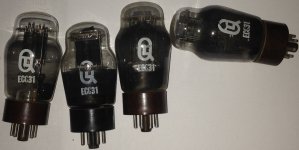Some tube types are much more prone to cathode interface aka "sleeping sickness" than others.
6AS7 and 6C33 benefit from long periods of running with filament power applied. When I did this I also arranged for some plate current to flow with comparatively low plate voltage.
The 6C33 at least seemed to have no problems with being heated for 24 hours or so without plate current, and was much less likely to arc after such treatment.
6AS7 and 6C33 benefit from long periods of running with filament power applied. When I did this I also arranged for some plate current to flow with comparatively low plate voltage.
The 6C33 at least seemed to have no problems with being heated for 24 hours or so without plate current, and was much less likely to arc after such treatment.
I finished testing 6P3S, now I work with a bunch of 600 pcs 6P3S-E. To these ones Ig1 is specified lower, max. 0.5mA, most of them show under 0.5, only few of them show over, no more than 3mA. After 1 to 3 hours of heating this big Ig1 disappear, the tubes being very good. I will not heat them more than an hour, even if some over Ig1 remain, tubes will be ok in the future amps when will be used. After 6p3s-e tubes, next one for testing will be 25 pcs of older ECC31, these are mine. Beside testing on tubetester I'll make an amp special for test and hear each one of them. I'm not sure they are Mullard, QTL is a brand only for sell tubes so they didn't made them. I have a project in the future to test and select pairs of GU81M tube, this one is a big one, work with high voltage and tubetester is useless. Theoretically it's simple, I select pairs that show the same anode current at the same bias and the same transconductance. Practically ... I'll see.
Attachments
I used to use a diode to drop the heater voltage on "standby" like in the old RCA TVs and after about 6 months the tubes (6P3S) were low emission, and tested bad. I now use a 10 second preheat before the B+ is applied (when the B+ is >400V).
Find the B + delay required only for eventual speakers protection or noise in the loudspeakers at start, not for tube protection. Only power radio frequency tubes required this delay (tubes >1kw and plate voltage >1kV. Small tubes don't need delay.
- Status
- This old topic is closed. If you want to reopen this topic, contact a moderator using the "Report Post" button.
